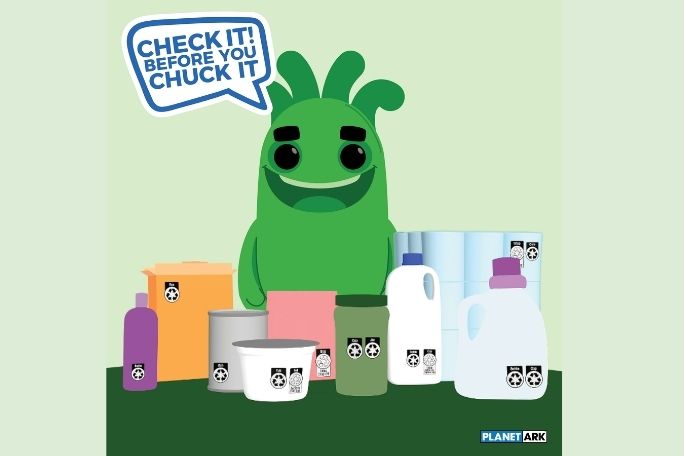Lesson summary
Students assume the role of a material scientist as they participate in hands-on investigations to sort and classify a range of items based on their properties. They work collaboratively, combining ideas to design a materials-sorting solution for a recycling facility and sharing their ideas with the class.
The lessons in this unit explore the purpose of the Australasian Recycling Label (ARL) and how to translate this understanding into environmental action. We recommend this lesson be used as part of a sequence of learning within this unit.
Learning intentions:
Students will...
- understand that materials have different properties
- identify if changes in materials are reversible or irreversible.
Success criteria:
Students can...
- explain that changes to materials can be reversible or irreversible;
- identify, plan and apply the elements of scientific investigations to answer questions and solve problems;
- use equipment and materials safely and identify potential risks;
- communicate ideas, explanations and processes using scientific representations using multimodality;
- describe how scientific knowledge is used to solve problems and inform personal and community decisions about recycling;
- plan and safely carry out a scientific investigation;
- apply scientific understandings to a design prototype and justify choices
- represent and communicate ideas
- describe how scientific knowledge helps us solve community problems.
Lesson guides and printables
Curriculum links
Select your curriculum from the options below.
Lesson details
Curriculum mapping
Australian Curriculum content descriptions:
Year 5 Science:
- Identify, plan and apply the elements of scientific investigations to answer questions and solve problems using equipment and materials safely and identifying potential risks (ACSIS103)
- Communicate ideas, explanations and processes using scientific representations in a variety of ways, including multi-modal texts (ACSIS110)
Year 6 Science:
- Changes to materials can be reversible or irreversible (ACSSU095)
- Identify, plan and apply the elements of scientific investigations to answer questions and solve problems using equipment and materials safely and identifying potential risks (ACSIS086)
- Communicate ideas, explanations and processes using scientific representations in a variety of ways, including multi-modal texts (ACSIS093)
Year 5 & 6 Design and Technology:
- Examine how people in design and technologies occupations address competing considerations, including sustainability in the design of products, services, and environments for current and future use (ACTDEK019)
- Critique needs or opportunities for designing, and investigate materials, components, tools, equipment and processes to achieve intended designed solutions (ACTDEP024)
- Generate, develop and communicate design ideas and processes for audiences using appropriate technical terms and graphical representation techniques (ACTDEP025)
Syllabus outcomes: ST3-4WS, ST3-12MW, ST3-14BE, ST3-15I, ST3-16P, ST3-5WT
General capabilities: Information and Communication Technology (ICT) Capability, Critical and Creative Thinking
Cross-curriculum priority: Sustainability
Relevant parts of Year 5 Science achievement standards: Students follow instructions to pose questions for investigation and predict the effect of changing variables when planning an investigation. They compare patterns in their data with predictions when suggesting explanations. Students describe ways to improve the fairness of their investigations, and communicate their ideas and findings.
Relevant parts of Year 6 Science achievement standards: Students compare and classify reversible and irreversible observable changes to materials. Students follow procedures to develop investigable questions and design investigations into simple relationships. They identify variables to be changed and measured and describe potential safety risks when planning methods. They describe and analyse relationships in data using appropriate representations to communicate ideas, methods and findings.
Relevant parts of Years 5 & 6 Design and Technology achievement standards: Students describe competing considerations in the design of products, services and environments, taking into account sustainability. Students create designed solutions and combine design ideas and communicate these to audiences using graphical representation techniques and technical terms.
This lesson is part of the wider unit of work Australasian Recycling Label
Time required: 60 mins
Level of teacher scaffolding: Medium – provide students with items to sort and classify, facilitating and modelling good classroom discourse. Assist students to combine ideas when designing their material recovery facility and provide ICT support as they represent their solution using digital technologies.
Resources required
- A range of packaging that varies in colour, weight, shape and texture. These could include a small plastic tub, a plastic bottle, a milk carton, a cardboard box, etc. It is recommended these items are selected from kitchen, laundry or bathroom products and that packaging that will definitely not have the ARL or a recycling label be avoided, such as takeaway containers or coffee cups. Make sure all items are clean and sharp edges are covered with masking tape.
- Advocate pack
- Butcher’s paper
- A device capable of presenting a video to the class
- Equipment and materials for the science investigation, including:
- A fan;
- Magnets; and
- A piece of red string
- Labels, hoops or boxes, otherwise segment the floor in some way using chalk or tape to allow for the sorting of items. Prepare this before starting the lesson.
Skills
This lesson is designed to build students’ competencies in the following skills:
- Communication
- Creativity
- Critical thinking
- Digital literacy
- Problem solving
- Collaboration
Additional info
This lesson has been developed as part of Planet Ark’s campaign around the Australasian Recycling Label and sustainable packaging. You can get involved during Planet Ark’s National Recycling Week or at any time during the school year and join thousands of amazing teachers in making a difference and creating positive environmental change. If you use any of these lessons, we highly recommend you submit an entry for the School’s Recycle Right Challenge in Term 4 and enter in the draw to win amazing prizes for your school!


Welcome back!
Don't have an account yet?
Log in with:
Create your free Cool.org account.
Many of our resources are free, with an option to upgrade to Cool+ for premium content.
Already have an account?
Sign up with:
By signing up you accept Cool.org's Terms and Conditions(Opens in new tab) and Privacy Policy(Opens in new tab).